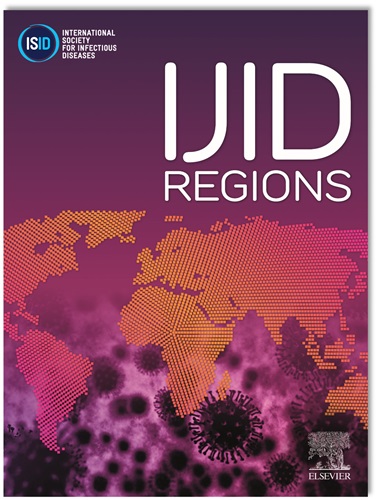Distinct urinary microbiome signatures are associated with urinary tract infection risk in patients with liver cirrhosis: A pilot study
IF 4.3
2区 医学
Q1 INFECTIOUS DISEASES
引用次数: 0
Abstract
Objectives
Individuals with liver cirrhosis are at increased risk of developing urinary tract infections (UTIs); however, the role of the urinary microbiome (UMB) in this susceptibility remains poorly understood. This pilot study aimed to characterize the UMB in patients with liver cirrhosis with and without UTIs using 16S rRNA gene sequencing.
Methods
Urine samples from 39 patients were analyzed: 17 who developed at least one UTI (dUTI) within 3 years and 22 who remained UTI-free (no_UTI). Microbial profiles were assessed via 16S rRNA gene sequencing and analyzed using QIIME 2, analysis of composition of microbiomes, and linear discriminant analysis effect size.
Results
Significant differences in beta diversity were observed between the dUTI and no_UTI groups (Bray-Curtis ADONIS: R2 = 0.044, P = 0.023; Jaccard ADONIS: R2 = 0.039, P = 0.028). The no_UTI group exhibited higher relative abundances of Bacteroidetes, Prevotella, and Corynebacteriaceae—microbes typically associated with a healthy urinary environment. In contrast, Streptococcus was enriched in the dUTI group.
Conclusions
Patients with liver cirrhosis who did not develop UTIs demonstrated distinct UMB patterns that may confer protection. These findings suggest that elements of the UMB, such as Prevotella and Corynebacterium, may play a protective role and represent potential targets for preventive strategies.
不同的尿微生物特征与肝硬化患者尿路感染风险相关:一项初步研究
背景:肝硬化患者发生尿路感染(uti)的风险增加,但尿微生物组(UMB)在这种易感性中的作用仍知之甚少。本初步研究旨在通过16S rRNA基因测序来表征合并和不合并尿路感染的肝硬化患者的UMB。方法:对39例患者的尿液样本进行分析,其中17例在三年内至少发生一次尿路感染(dUTI), 22例没有尿路感染(no_UTI)。通过16S rRNA基因测序评估微生物谱,并使用QIIME 2、ANCOM和LEfSe进行分析。结果:dUTI组与no_UTI组β多样性差异有统计学意义(Bray-Curtis ADONIS: R2=0.044, p=0.023; Jaccard ADONIS: R2=0.039, p=0.028)。no_UTI组显示出较高的拟杆菌门、普雷沃氏菌和棒状杆菌科的相对丰度,这些微生物通常与健康的泌尿环境有关。相比之下,dUTI组链球菌富集。结论:未发生尿路感染的肝硬化患者表现出不同的UMB模式,可能具有保护作用。这些发现表明UMB的元素,如普雷沃氏菌和棒状杆菌,可能发挥保护作用,并代表预防策略的潜在目标。
本文章由计算机程序翻译,如有差异,请以英文原文为准。
求助全文
约1分钟内获得全文
求助全文
来源期刊
CiteScore
18.90
自引率
2.40%
发文量
1020
审稿时长
30 days
期刊介绍:
International Journal of Infectious Diseases (IJID)
Publisher: International Society for Infectious Diseases
Publication Frequency: Monthly
Type: Peer-reviewed, Open Access
Scope:
Publishes original clinical and laboratory-based research.
Reports clinical trials, reviews, and some case reports.
Focuses on epidemiology, clinical diagnosis, treatment, and control of infectious diseases.
Emphasizes diseases common in under-resourced countries.

 求助内容:
求助内容: 应助结果提醒方式:
应助结果提醒方式:


